- Home
- Robert K. Massie
Peter the Great Page 4
Peter the Great Read online
Page 4
Soon afterward, the subject of all this celebration, surrounded by his own small, private household staff, was moved into his suite of rooms. He had a governess, a wet nurse—"a good and clean woman with sweet and healthy milk"—and a staff of dwarfs especially trained to act as servants and playmates to the royal children. When Peter was two, he and his retinue, now grown to include fourteen attending gentlewomen, moved into a grander Kremlin apartment—the walls hung with deep red fabrics, the furniture upholstered in crimson and embroidered with threads of gold and bright blue. Peter's clothes—miniature caftans, shirts, vests, stockings and caps—were cut from silk, satin and velvet, embroidered with silver and gold, buttoned and tasseled with sewn clusters of pearls and emeralds.
A doting mother, a proud father and a pleased Matveev competed to lavish gifts on the child, and Peter's nursery soon overflowed with elaborate models and toys. In one corner stood a carved wooden horse with a leather saddle studded with silver nails and a bridle decorated with emeralds. On a table near the window rested an illuminated picture book, painstakingly made for him by six icon painters. Music boxes and a small, elegant clavichord with copper strings were brought from Germany. But Peter's favorite toys and his earliest games were military. He liked to bang on cymbals and drums. Toy soldiers and forts, model pikes, swords, arquebuses and pistols spread across his tables and chairs and floor. Next to his bed, Peter kept his most precious toy, given to him by Matveev, who had bought it from a foreigner: a model of a boat.
Intelligent, active and noisy, Peter grew rapidly. Most children walk at around one year; Peter walked at seven months. His father liked taking this healthy little Tsarevich with him on excursions around Moscow and to the royal villas outside the capital. Sometimes he went to Preobrazhenskoe, the informal retreat where Matveev had built a summer theater; this quiet place on the banks of the Yauza River beyond the German Suburb was Natalya's favorite. But more often he was taken to the architectural marvel of Alexis' reign, the huge palace at Kolomenskoe.
This immense building, constructed entirely of wood, was regarded by Russian contemporaries as the Eighth Wonder of the World. Standing on a bluff overlooking a bend in the Moscow River, it was an exotic jumble of shingled onion domes, tent roofs, steep pyramidal towers, horseshoe arches, vestibules, latticed stairways, balconies and porches, arcades, courtyards and gateways. A separate three-storied building, with two peaked towers, served as the private apartment of Peter and his half-brother Ivan. Although from the outside it seemed a crazy quilt of old Russian architecture, the palace had many modern features. There were baths not only for members of the family, but also for the servants (the palace of Versailles, constructed at roughly the same time, was built without either baths or toilets). The wooden walls of the Kolomenskoe palace were pierced by 3,000 mica-paned windows, and light streamed in on 270 rooms decorated in modern, secular style. Brightly painted scenes decorated the ceilings, mirrors and velvet drapes hung on the walls, interspersed with portraits of Julius Caesar and Alexander the Great. The silver throne, studded with gems, on which Alexis received his visitors was flanked by two giant bronze lions. When the Tsar pushed a lever, the eyes of these mechanical beasts would roll, their jaws would open, and from their throats came a hoarse, brassy roar.*
Natalya preferred the less formal daily routine in these suburban palaces to that in the Kremlin. Hating the stuffy air of the Tsaritsa's closed carnage, she raised its curtains—in public—and was soon riding to and from the country, and once even in a state procession, in an uncovered carriage with her husband and child. Because it was easier for her to watch, Alexis received foreign ambassadors at Kolomenskoe rather than at the Kremlin. In 1675, the procession of the arriving Austrian ambassador was deliberately slowed as it passed the window where the Tsaritsa sat, so that she might have more time to observe. This same diplomat, waiting to be presented to the Tsar, caught a glimpse of Peter: "The door opened suddenly and Peter, three years old, a curly-headed boy, was seen for a moment holding his mother's hand."
Later that year, Peter was regularly seen in public. Alexis had ordered several of the large, gilded court carriages used by other contemporary European monarchs. Matveev, knowing exactly how to please, thereupon ordered a miniature copy of one of these carriages and presented it to Peter. This tiny coach, "inset with gold ornament, drawn by four dwarf ponies, with four dwarfs riding at the side and another dwarf behind," became a favorite sight on state occasions.
Alexis had five years with Natalya Naryshkina. A second child, named Natalya after her mother, was born and lived; a third child, again a daughter, was born and died. At court, the effect of the marriage had been strongly felt. The austere, painfully religious quality of Alexis' earlier years gave way to a new, more relaxed spirit, a greater readiness to accept Western ideas, entertainments and techniques. But the greatest effect was on the Tsar himself.
*In 1771, exactly 100 years after it was built, the great wooden palace was torn down by Catherine the Great.
Marriage to this young wife revived and delighted him. The last years of his life were the happiest.
Suddenly, when Peter was only three and a half, the serenity of his nursery life was shattered. On Epiphany in January 1676, Tsar Alexis, at forty-seven, healthy and active, took part in the annual ceremony of the blessing of the waters of the Moscow River. Standing in the frozen winter air during the long ceremony, he caught a chill. A few days later, in the middle of the performance of a play, the Tsar left die Kremlin theater and went to bed. At first, the illness did not seem dangerous. Nevertheless, it grew steadily worse, and after ten days, on February 8, Tsar Alexis died.
At a stroke, Peter's world changed. He had been the adored small son of a father who doted on his mother; now he was the potentially troublesome offspring of his dead father's second wife. The successor to the throne was fifteen-year-old Fedor, the semi-invalid eldest surviving son of Maria Miloslavskaya. Although Fedor had never been well, in 1674 Alexis had formally declared him to be of age, recognized him as heir and presented him as such to his subjects and the foreign ambassadors. At that time, it had seemed only a formality; Fedor's health was so delicate and Alexis' so good that few thought the delicate son would live to succeed the robust father.
But now it had happened: Fedor was Tsar, and the great pendulum of power had swung back again from Naryshkin to Miloslavsky. Although his legs were so swollen that he had to be carried to his coronation, Fedor was crowned without opposition. The Miloslavskys came flooding triumphantly back to office. Fedor himself bore no ill-will against his step-mother, Natalya, or his little half-brother, Peter, but he was only fifteen and could not completely resist the power of his Miloslavsky relatives.
At the head of this clan stood his uncle Ivan Miloslavsky, who had hastened back from his post as Governor of Astrachan to replace Matveev as chief minister. That Matveev himself, as effective leader of the Naryshkin party, would in turn be banished to some ceremonial post was expected; it was an accepted accompaniment to the swing of the pendulum; it would balance the sending of Miloslavsky to Astrachan. The Tsaritsa Natalya, therefore, was saddened but resigned when her foster father was ordered to depart for Siberia to become Governor of Verkoture, a province in the northwestern part of that immense territory! But she was shocked and terrified when she learned that, en route to his new post, Matveev had been overtaken by new orders from Ivan Miloslavsky: Matveev was to be arrested, stripped of all his property and conducted as a state prisoner to Pustozersk, a remote town north of the Arctic Circle. (Actually, Ivan Miloslavsky's fear of his powerful rival had driven him even further he had tried to have Matveev condemned to death, charging him with theft from the Treasury, the use of magic and even an attempt to poison Tsar Alexis. Ivan Miloslavsky pressed young Fedor hard, but the Tsar refused the death sentence and Miloslavsky had to settle for Matveev's imprisonment.)
Deprived of their powerful champion, and with their other supporters pushed from office, Natalya and her two children
faded from public.view. At first, Natalya feared for her children's physical safety; her son, three-and-a-half-year-old Peter, remained the Naryshkin party's hope for the future. But as time passed, the Tsaritsa relaxed; the life of a royal prince was still considered sacred, and Tsar Fedor never exhibited toward his newly poor relations anything but sympathy and kindness. They remained in the Kremlin, cloistered in their private apartments. There Peter began his education. At that time in Muscovy, most people, even among the gentry and the clergy, were illiterate. In the nobility, education rarely consisted of more than reading, writing and a smattering of history and geography. Instruction in grammar, mathematics and foreign languages was reserved for religious scholars who needed these tools to grapple with theology. There were exceptions: two of Tsar Alexis' children, Fedor and his sister the Tsarevna Sophia, had been placed in the hands of famous theological scholars from Kiev, had received a thorough classical education and could speak the foreign languages of a truly learned seventeenth-century Muscovite, Latin and Polish.
Peter's education began simply. At three, when his father was still alive, he had been given a primer to start learning the alphabet. When he reached five, Tsar Fedor, who was his godfather as well as his half-brother, said to Natalya, "Madam, it is time our godson started his lessons." Nikita Zotov, a clerk who worked in the tax-collection department, was selected as Peter's tutor. Zotov, an amiable, literate man who knew the Bible well but was not a scholar, was overwhelmed at being chosen for his role. Trembling, he was led to the Tsaritsa, who received him with Peter at her side. "You are a good man well versed in the Holy Writ," she said, "and I entrust to you my only son." Whereupon Zotov flung himself on the ground and burst into tears. "Matushka," he cried, "I am not worthy to look after such a treasure!" The Tsaritsa gently raised him up and told him that Peter's lessons would begin the next day. To encourage Zotov, the Tsar gave him a suite of apartments and raised him to the rank of minor nobleman, the Tsaritsa presented him with two complete sets of new clothes and the Patriarch gave him 100 rubles.
On the following morning, with both Tsar and Patriarch present to watch, Zotov gave Peter his first lesson. The new schoolbooks were sprinkled with holy water, Zotov bowed low to his small pupil and the lesson began. Zotov started with the alphabet and, as time passed, went on to the Prayer Book and the Bible. Long passages of Holy Scripture, drilled into Peter's early memory, remained with him permanently; forty years later, he could recite them by heart, He was taught to sing the magnificent Russian choral litany, and he took great pleasure in his talent. In later years, traveling through Russia, Peter often attended services in country churches. His practice on these occasions was to stride straight up to the choir and sing along in a loud voice.
Zotov's assignment had been only to teach Peter to read and write, but he found his pupil eager to go further. Peter constantly urged Zotov to tell him more stories of Russian history, of battles and heroes. When Zotov mentioned the boy's enthusiasm to Natalya, she commissioned master engravers from the Ordnance Office to compose books of colored drawings depicting foreign cities and palaces, sailing ships, weapons and historical events. Zotov placed this collection in Peter's room so that when the boy was bored with his regular lessons, these books could be brought out, looked at and discussed. A giant globe, taller than a man, sent to Tsar Alexis from Western Europe, was brought to the schoolroom for Peter to study. Its depiction of the geography of Europe and Africa was remarkably accurate. The details of the eastern coast of North America were also correct—Chesapeake Bay, Long Island and Cape Cod were all precisely drawn-—but farther west the lines became more inexact. California, for example, was shown as separate from the rest of the continent.
In the schoolroom, Zotov won Peter's deep affection and for as long as the tutor lived, Peter kept him close. Zotov has been criticized for giving his pupil an inferior education, inadequate to the needs of a boy who would be tsar, yet at the time of these lessons Peter stood behind his two half-brothers, Fedor and Ivan, in the succession. His education, though less severely classical than that given to Fedor and Sophia, was far better than that of the average Russian nobleman. Most important, it was perhaps the best education for a mind like Peter's: He was not a scholar, but he was unusually open and curious, and Zotov stimulated this curiosity; it is doubtful that anyone could have done better. Strange though it may seem, when this royal prince who was to become an emperor reached manhood, he was, in large part, a self-taught man. From his earliest years, he himself had chosen what he wished to learn. The mold which created Peter the Great was not made by any parent, tutor or counselor; it was cast by Peter himself.
Between classroom and play in the Kremlin and at Kolomenskoe, Peter's life passed uneventfully during the six years (1676-1682) of Fedor's reign. Fedor seemed very much his father's son—mild-mannered, indulgent and relatively intelligent, having been educated by the leading scholars of the day. Unfortunately, his scurvy-like disease frequently forced him to rule Russia lying on his back.
Nevertheless, Fedor did carry out one great reform, the abolition of the medieval system of precedence, a crushing weight on public administration, which decreed that noblemen could only accept state offices or military commands according to their rank. And to prove his rank, every boyar jealously guarded his family records. There were endless squabbles, and it became impossible to put capable men in key positions because others, citing higher rank, would refuse to serve under them. This system enshrined incompetence, and in the seventeenth century, in order to field an army at all, the tsars had been forced to set the system aside temporarily and declare that wartime commands would be assigned "without precedence."
Fedor wanted to make these temporary waivers permanent. He appointed a commission which recommended the permanent abolition of precedence; then he called a special council of boyars and clergy and personally urged the abolition of the welfare of the state. The Patriarch enthusiastically supported him. The boyars, suspicious and reluctant to give up the hallowed prerogatives of rank, grudgingly agreed. Fedor ordered that all family documents, service books and anything pertaining to previous precedence and rank be surrendered. Before the eyes of the Tsar, the Patriarch and the council, these were wrapped in bundles, carried into a Kremlin courtyard and tossed into the flames of a bonfire. Fedor decreed that thereafter offices and power would be distributed on a basis of merit and not of birth, a principle which Peter would subsequently make the foundation of his own military and civilian admistration. (Ironically, many boyars, seeing their ancient privileges go up in smoke, silently cursed Fedor and the Miloslavskys and thought of the young Peter as a potential savior of the old ways.)
Although he had married twice in his brief life, Fedor died without an heir. His first wife died in childbirth, followed a few days later by her newborn son. The death of this infant and Fedor's declining health increased the uneasiness of the Miloslavskys, who urged Fedor to marry again. He agreed, despite the warnings of doctors that the exertions of marriage would kill him, because he had fallen in love with a beautiful, high-spirited, fourteen-year-old girl. Martha Apraxina was not the choice of the Miloslavskys; rather she was a goddaughter of Matveev, and she asked, as a condition of her marriage, that the imprisoned statesman be pardoned and his property restored. Fedor agreed, but before the godfather could arrive in Moscow to congratulate the bride in person, the Tsar, two and a half months after his wedding, was dead.
Since Michael Romanov's accession in 1613, each tsar had been succeeded by his eldest surviving son: Michael had been succeeded by his eldest surviving son, Alexis, and Alexis by his eldest surviving son, Fedor. In each case, before his own death, the tsar had formally presented this eldest son to the people and officially designated him the heir to the throne. But now Fedor had died without leaving a son or designating an heir.
The two surviving candidates were Fedor's sixteen-year-old brother, Ivan, and his ten-year-old half-brother, Peter. Normally, Ivan, who was-six years older than Peter as wel
l as being the son of Alexis' first wife, would have been the uncontested choice. But Ivan was nearly blind, lame and spoke with difficulty, whereas Peter was active, glowing and big for his age. More important, the boyars knew that, whichever boy ascended the throne, the actual power would be in the hands of a regent. By now, most of them were antagonistic to Ivan Miloslavsky and preferred Matveev, who, under the nominal regency of the Tsaritsa Natalya, would weild power if Peter became tsar.
The decision came immediately after the boyars' final leavetaking of Tsar Fedor. One by one, the boyars passed the bed on which the dead Tsar lay, stopping to kiss the cold white hand. Then the Patriarch Joachim and his bishops entered the crowded room, and Joachim posed the formal question, "Which of the two princes shall be tsar?" Arguments followed; some supported the Miloslavskys, saying that Ivan's claim was strongest; others urged that it was impractical and foolish to continue the rule of the Russian state from a sickbed. The discussion grew hot, and finally, out of the uproar, the cry was heard: "Let the people decide!"
In theory, "the people" meant that the tsar should be elected by a Zemsky Sobor, an Assembly of the Land, a gathering of noblemen, merchants and townspeople from all parts of the Muscovite state. It was an Assembly of the Land which in 1613 had pursuaded the first Romanov, sixteen-year-old Micheal, to accept the throne, and which had ratified the succession of Alexis. But such an assembly could not be gathered for weeks. Thus, at that moment, "the people" meant the Moscow crowd massed outside the palace windows.
The bells of the Ivan the Great bell tower sounded, and the Patriarch, the bishops and the boyars walked to the porch at the top of the Red Staircase overlooking Cathedral Square. Looking out over the crowd, the Patriarch cried, "The Tsar Fedor Alexeevich of blessed memory is dead. He leaves no heirs but his brothers, the Tsarevich Ivan Alexeevich and the Tsarevich Peter Alexeevich. To which of the two princes do you give the rule?" There were loud shouts of "Peter Alexeevich" and a few cries of "Ivan Alexeevich," but the shouts for Peter became louder and drowned out the others. The Patriarch thanked and blessed the crowd. The choice was made.

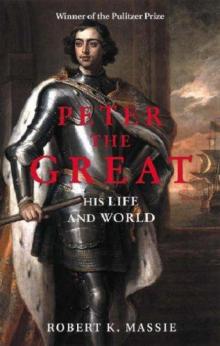 Peter the Great
Peter the Great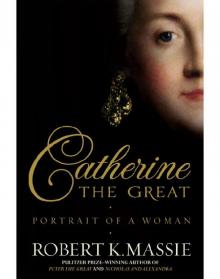 Catherine the Great
Catherine the Great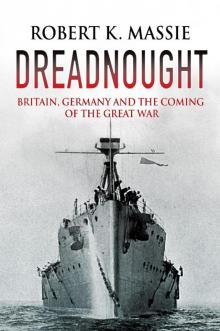 Dreadnought
Dreadnought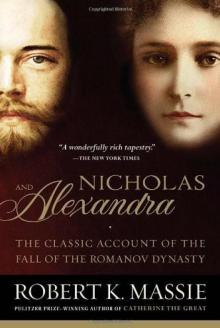 Nicholas and Alexandra: The Classic Account of the Fall of the Romanov Dynasty
Nicholas and Alexandra: The Classic Account of the Fall of the Romanov Dynasty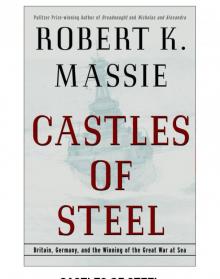 Castles of Steel
Castles of Steel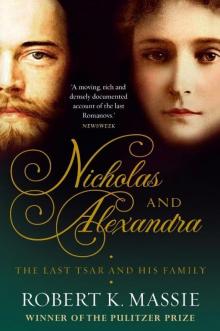 Nicholas and Alexandra: The Tragic, Compelling Story of the Last Tsar and his Family
Nicholas and Alexandra: The Tragic, Compelling Story of the Last Tsar and his Family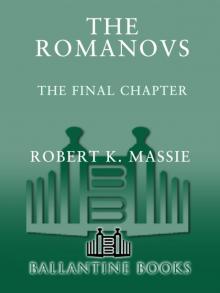 The Romanovs
The Romanovs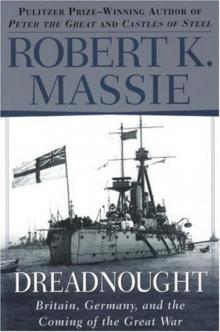 Dreadnought, Britain, Germany and the Coming of the Great War
Dreadnought, Britain, Germany and the Coming of the Great War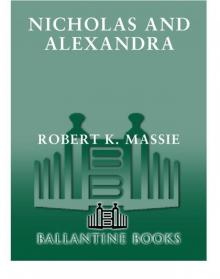 Nicholas and Alexandra
Nicholas and Alexandra